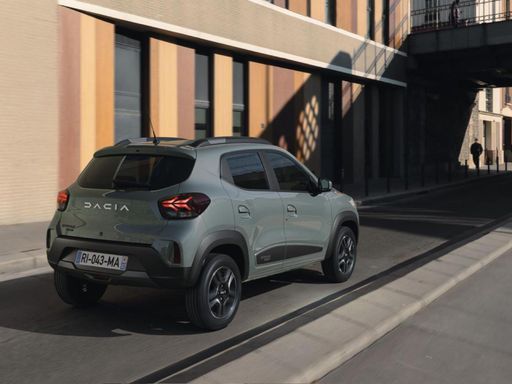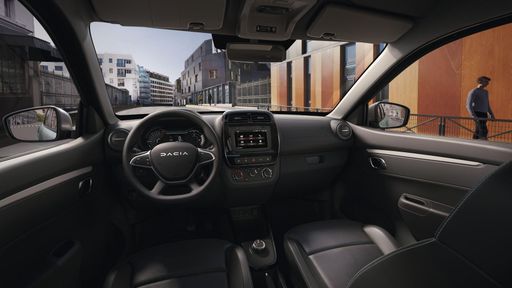Dacia Spring vs Renault Express – Differences & prices compared
Both models have their strengths – but which one suits you more?
Compare performance, efficiency, price and space directly: Dacia Spring or Renault Express?
Costs and Efficiency:
Price and efficiency are key factors when choosing a car – and this is often where the real differences emerge.
Dacia Spring has a to a small extent advantage in terms of price – it starts at 14500 £, while the Renault Express costs 17100 £. That’s a price difference of around 2640 £.
Engine and Performance:
Power, torque and acceleration are the classic benchmarks for car enthusiasts – and here, some clear differences start to show.
When it comes to engine power, the Renault Express has a distinct edge – offering 102 HP compared to 65 HP. That’s roughly 37 HP more horsepower.
In acceleration from 0 to 100 km/h, the Renault Express is a bit quicker – completing the sprint in 11.90 s, while the Dacia Spring takes 13.70 s. That’s about 1.80 s faster.
In terms of top speed, the Renault Express performs noticeable better – reaching 167 km/h, while the Dacia Spring tops out at 125 km/h. The difference is around 42 km/h.
There’s also a difference in torque: Renault Express pulls decisively stronger with 240 Nm compared to 125 Nm. That’s about 115 Nm difference.
Space and Everyday Use:
Beyond pure performance, interior space and usability matter most in daily life. This is where you see which car is more practical and versatile.
Seats: Dacia Spring offers convincingly more seating capacity – 4 vs 2.
In curb weight, Dacia Spring is clearly perceptible lighter – 1013 kg compared to 1296 kg. The difference is around 283 kg.
In maximum load capacity, the Renault Express performs convincingly better – up to 3300 L, which is about 2296 L more than the Dacia Spring.
When it comes to payload, Renault Express decisively takes the win – 700 kg compared to 302 kg. That’s a difference of about 398 kg.
Who comes out on top?
Overall, the Renault Express shows itself to be dominates this comparison and secures the title of DriveDuel Champion.
It convinces with the more balanced overall package and proves to be the more versatile choice for everyday use.
Renault Express
Dacia Spring
The Dacia Spring stands out as an affordable and environmentally friendly option in the electric vehicle market, combining practicality with a compact design ideal for urban settings. Its minimalist interior, while basic, provides all the essential features needed for a comfortable drive, reflecting its cost-effective approach. The vehicle's performance suits city driving, making it an appealing choice for those seeking an entry-level electric car.
details @ dacia-presse.de
@ dacia-presse.de
 @ dacia-presse.de
@ dacia-presse.de
 @ dacia-presse.de
@ dacia-presse.de
Renault Express
The Renault Express brings a fresh design to the van segment, combining practicality with modern styling cues. Its spacious interior and clever storage solutions make it an ideal choice for both business and leisure purposes. With a focus on comfort and functionality, this vehicle stands out as a versatile option for those in need of reliable transportation.
details

|
|
|
|
|
Costs and Consumption |
|
|---|---|
|
Price
14500 - 17100 £
|
Price
17100 - 19500 £
|
|
Consumption L/100km
-
|
Consumption L/100km
4.6 - 6.6 L
|
|
Consumption kWh/100km
13.2 - 14.1 kWh
|
Consumption kWh/100km
-
|
|
Electric Range
225 - 228 km
|
Electric Range
-
|
|
Battery Capacity
26.80 kWh
|
Battery Capacity
-
|
|
co2
0 g/km
|
co2
121 - 149 g/km
|
|
Fuel tank capacity
-
|
Fuel tank capacity
50 L
|
Dimensions and Body |
|
|---|---|
|
Body Type
SUV
|
Body Type
Cargo Van
|
|
Seats
4
|
Seats
2
|
|
Doors
5
|
Doors
4
|
|
Curb weight
1013 - 1050 kg
|
Curb weight
1296 - 1390 kg
|
|
Trunk capacity
308 L
|
Trunk capacity
-
|
|
Length
3701 mm
|
Length
4393 mm
|
|
Width
1583 mm
|
Width
1775 mm
|
|
Height
1519 mm
|
Height
1811 mm
|
|
Max trunk capacity
1004 L
|
Max trunk capacity
3300 L
|
|
Payload
265 - 302 kg
|
Payload
575 - 700 kg
|
Engine and Performance |
|
|---|---|
|
Engine Type
Electric
|
Engine Type
Diesel, Petrol
|
|
Transmission
Automatic
|
Transmission
Manuel
|
|
Transmission Detail
Reduction Gearbox
|
Transmission Detail
Manual Gearbox
|
|
Drive Type
Front-Wheel Drive
|
Drive Type
Front-Wheel Drive
|
|
Power HP
44 - 65 HP
|
Power HP
75 - 102 HP
|
|
Acceleration 0-100km/h
13.7 - 19.1 s
|
Acceleration 0-100km/h
11.9 - 16.3 s
|
|
Max Speed
125 km/h
|
Max Speed
100 - 167 km/h
|
|
Torque
113 - 125 Nm
|
Torque
200 - 240 Nm
|
|
Number of Cylinders
-
|
Number of Cylinders
4
|
|
Power kW
33 - 48 kW
|
Power kW
55 - 75 kW
|
|
Engine capacity
-
|
Engine capacity
1332 - 1461 cm3
|
General |
|
|---|---|
|
Model Year
2024
|
Model Year
2021
|
|
CO2 Efficiency Class
A
|
CO2 Efficiency Class
D, E
|
|
Brand
Dacia
|
Brand
Renault
|
What drive types are available for the Dacia Spring?
The Dacia Spring is available as Front-Wheel Drive.
The prices and data displayed are estimates based on German list prices and may vary by country. This information is not legally binding.
